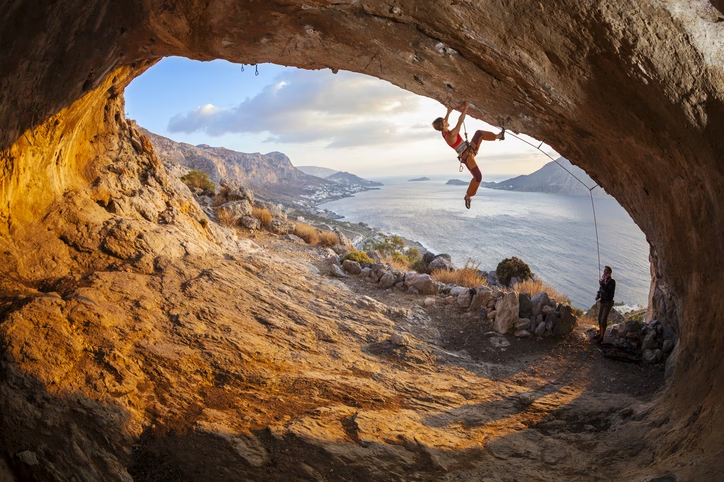Belaying is one of the most critical aspects of rock climbing, ensuring the safety and security of both the climber and the belayer. As a belayer, you manage the rope, catch falls, and provide essential support throughout the climb. Mastering belaying techniques can significantly enhance your climbing experience and help prevent accidents. These lessons come from what I have observed along my climbing journey, and I hope they can help you stay safer and more confident on the wall.
Table of Contents
Belaying Tips for A Safer Climb
Always Double-Check Your Setup
Before your climbing partner starts their ascent, performing a thorough safety check is crucial to avoid potential mishaps.

- Inspect the Harness: Ensure both you and your climber’s harnesses are properly fastened with doubled-back buckles.
- Check the Belay Device: Confirm the rope is threaded correctly through the belay device with the brake side positioned for easy handling.
- Lock the Carabiner: Make sure the carabiner is locked and properly oriented to prevent cross-loading.
- Tie-In Verification: Verify the climber’s knot is secure and correctly tied.
- Verbal Confirmation: Use commands like “Belay on?” and “Climbing?” to establish clear communication.
Taking a few extra seconds to double-check the setup ensures a safer climb for everyone involved.
Maintain a Solid Stance
A stable stance while belaying allows you to react quickly and efficiently to any falls or movements your climber makes.

- Positioning: Stand close to the wall with your feet shoulder-width apart to maintain balance.
- Stay Engaged: Avoid sitting or leaning; standing allows for better responsiveness.
- Brake Hand Ready: Always keep your brake hand on the rope to ensure immediate control.
Proper positioning and engagement during belaying help maintain a secure and controlled climb. I struggled with both of these so I know that it could be difficult but practice makes perfect.
Use the Correct Belaying Technique
Using the right technique is fundamental to safely managing the rope and climber.
- PBUS Method: The “Pull, Brake, Under, Slide” technique ensures smooth and controlled rope handling.

- Controlled Slack Management: Provide enough slack for movement without creating excessive looseness.
- Avoid Gripping Too Tightly: Keeping a firm but relaxed grip allows smoother feeding and locking.
Practicing belaying techniques regularly builds muscle memory and enhances your confidence. Refining these techniques made me not only trust myself when belaying but also when getting belayed. Understanding it is the best way to rid of the fear.
Lead Belaying vs. Top Rope Belaying
There are key differences between lead belaying and top rope belaying that belayers should be aware of:
- Lead Belaying:
- Requires providing slack as the climber ascends and clips into protection points.
- Anticipating the climber’s movements is crucial to prevent too much or too little slack.
- Quick and responsive braking is essential to catch sudden falls.
- More dynamic belay techniques may be needed to absorb fall forces smoothly.

- Top Rope Belaying:
- The rope is already secured at the top anchor, making slack management less complex.
- Consistently taking in rope as the climber ascends is the primary focus.
- Typically results in shorter falls, requiring less dynamic response.
- Easier to manage for beginners due to its simplicity and predictability.
Understanding these differences helps belayers provide the appropriate level of support and safety for each climbing style.
Communicate Clearly
Effective communication between the climber and belayer is essential for a smooth climbing experience.

- Use Standard Commands: “Climbing!”, “Take!”, and “Lowering!” to avoid misunderstandings.
- Pre-Climb Discussion: Discuss expectations and potential challenges before starting.
- Maintain Eye Contact: Visual communication can provide cues on how your climber is feeling.
Good communication builds trust and reduces the risk of mistakes.
Stay Focused and Minimize Distractions
Belaying requires your full attention—getting distracted, even for a moment, can lead to dangerous situations.
- Avoid Conversations: Stay focused and avoid unnecessary interactions.
- Be Ready for Falls: Stay alert, especially when your climber is attempting a tough move.
- Take Breaks Wisely: If you need to rest, ensure your climber is in a secure position first.

Remaining attentive throughout the climb is crucial for your partner’s safety. This is something I see many people struggle with.
Master the Art of Catching Falls
Catching falls is a key part of belaying and must be done correctly to minimize impact.
- Keep a Firm Grip: Always maintain a strong hold on the brake side of the rope.
- Lock the Device: Pull the brake side down firmly to arrest a fall.
- Provide a Soft Catch: Allowing a small amount of rope to slide can reduce the force of impact.
- Check In: After a fall, ask the climber if they are okay before continuing.
Practicing fall catches in a controlled environment helps build confidence in handling real scenarios.

Belaying is a skill that demands attention, responsibility, and continuous practice. Ensuring proper technique, communication, and focus will help you become a reliable belayer and foster trust with your climbing partner. Personally, I recommend the Petzl GriGri+ as my go-to belay device for its added safety features and smooth handling—perfect for both beginners and experienced climbers.
Stay vigilant, stay safe, and enjoy your climbs!
FAQs
How to Belay?
To belay safely, follow the PBUS method: Pull, Brake, Under, and Slide. Always keep your brake hand on the rope and ensure smooth rope management.
What is Belaying?
Belaying is the process of managing the climbing rope to secure a climber, prevent falls, and provide controlled lowering when needed.
How to Lead Belay?
Lead belaying involves managing rope slack efficiently, anticipating climber movements, and being prepared to catch dynamic falls.
How to Use a Belay Device?
Thread the rope through the device according to the manufacturer’s instructions, lock the carabiner, and always control the brake side of the rope.
How to Belay with a GriGri?
Using a GriGri requires correct rope threading, controlled feeding, and engagement of the assisted braking system to ensure a safe belay experience.


